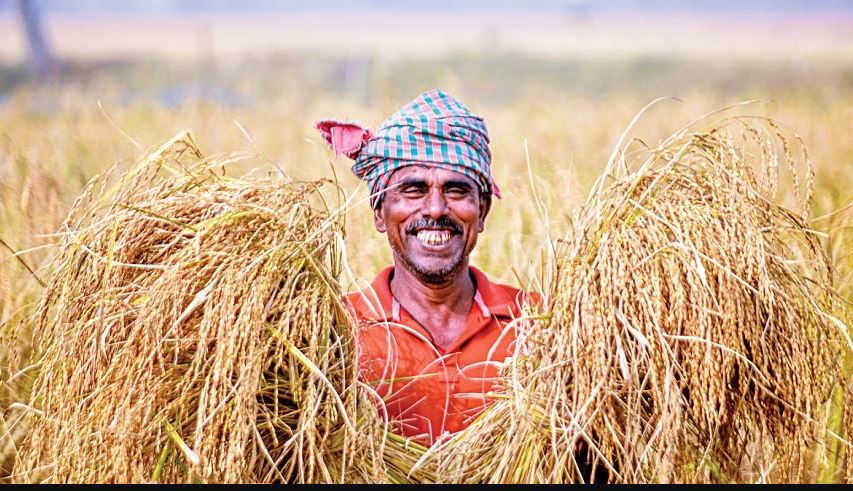When Abdul Haque woke up at dawn yesterday, not even the bone-chilling cold or the fog could stop him from getting out onto the field.
The 46-year-old, like the past couple of days, rushed out to his field in Barishal’s Bakerganj to harvest the Aman paddy he had planted during the monsoon.
“It’s so foggy that I couldn’t even see the farmers right next to me,” he said after returning from gathering crops at noon.
For many years, Abdul has been cultivating Aman, the second biggest crop after Boro, on nearly six acres of land, a portion of which he had rented out from other landowners.
The yield, a part of which he stores for his family, was satisfactory, validating his hard work through the sun, rain and cold.
Like Abdul, farmers across the country could be seen on the fields from dawn to dusk, working tirelessly to produce food for the nation.
They do all this without even the assurance of profitable prices or an improvement of their living standards.
Throughout the year 2022, they have remained on the fields to produce food – rice, vegetables, oilseeds, pulses, maize, and more – to keep the nation from depending on the global market, as the prices there have increased to unprecedented levels due to the Russia-Ukraine war and the Covid-19 pandemic fallout.
Their efforts to grow food continued at a time when Bangladesh economy faced myriad challenges — the dollar crisis resulting from higher import bills than export and remittance earnings; and high prices of fuel, fertiliser, food commodities.
Despite repeated natural calamities, namely flood and scanty rainfall, a high amount of Aman is being harvested in many parts of the country.
Crop production estimates by the Bangladesh Bureau of Statistics, the national statistical agency, are yet to be available.
However, Bangladesh Rice Research Institute (BRRI) estimates 2022’s Aman rice production at 1.63 crore tonnes, which is a record high.
Including Aman, farmers bagged 3.97 crore tonnes of various grains of rice last year — much higher than the consumption requirement of 2.51 crore tonnes at 405 grams per capita per day, said BRRI Director General Md Shahjahan Kabir at an event yesterday.
“There will be no crisis of rice in the country until next June even after we consider an estimation error.”
Also, international agencies namely US Department of Agriculture earlier forecast an increase in Aman rice production.
It said Boro, which accounts for more than half of the total yearly rice production, grew from 1.93 crore tonnes to 1.97 crore tonnes in 2022 thanks to handwork of farmers.
However, farmers could not bag the full production of Aush, which accounts for less than 10 percent of the total rice production per year, as severe floods hit the north and northeastern parts of the country during planting, said the USDA in its Grain and Feed Update in late October on Bangladesh.
In early December, the Food and Agriculture Organisation in its report, titled Crop Prospects and Food Situation, forecast that Bangladesh would harvest 5.64 crore tonnes of paddy in 2022, which was marginally lower than the previous year but higher than five-year average of 5.49 crore tonnes.
The UN agency also predicted higher production of wheat and maize in Bangladesh in 2022 compared to the previous year.
Mohammad Jahangir Alam, professor of Agribusiness and Marketing at the Bangladesh Agricultural University, said 2022 was challenging for farmers due to high prices of fuel and fertiliser, while natural calamities raised concerns over rice production.
However, despite the concerns, rice production was satisfactory.
“Credit goes to our farmers. They continued their work despite the increase in production cost, and the country has not fallen in a food crisis.”
He added the government and agricultural agencies also worked proactively and stood by farmers.
The vegetable production throughout the year has also seen success thanks to the farmers, who have turned the country almost self-reliant with regard to rice and veggies even after natural disasters such as flood, cyclones and other unpredictable climate change effects.
While all this portrayed success of our farmers, there are still certain aspects that are holding them back.
While the number of arable lands is falling, the cost of production is increasing due to higher costs of labour, irrigation and fertiliser. This has been making it harder for marginal farmers to make a profit.
They, however, have not given up.
In the year 2020, when Covid-19 had the world in its deadly grip, forcing the country to opt for lockdown and bringing the economy to a standstill, it was the farmers who still went out to the fields and worked relentlessly to keep the flow of food steady for the nation.
Today, the farmers grow more than two crops a year as reflected in a cropping intensity (how many crops are cultivated in a land per year) of 214, up from 173 in 2008.
In 2020, Bangladesh was listed as the third highest rice producing country in the world.
It also ranked third in vegetable production, said Bangladesh Agriculture Information Service, citing a report of the UN’s Food and Agriculture Organisation from last March.
Meanwhile, the USDA, in another report, said the country is also third in aquaculture and fish production after India and China.
However, the impact of farmers and their success is even higher.
The FAO report states that the fruit production in Bangladesh has increased by 11 percent on average for 18 consecutive years.
The country ranks second in jackfruit production, seventh in mango production, eighth in guava production and 14th in papaya production.
Meanwhile, the consumption of fruits has also increased twofold over the last decade.
Anu Muhammad, a former economics professor at Jahangirnagar University, said food availability per capita has almost doubled in the last 50 years.
“Food production has increased but the fate of ordinary farmers has not improved as the marketing system is unfavourable for them. The input price for agriculture is also high and bank loans are not available for them.”
Bibhash Mondol, a small farmer from Batiaghata in the southwest district Khulna, said they could not get higher prices for their paddy due to what he said was the local business syndicate.
“They [the syndicate] have fixed the price rate in the local market and we do not get more than that,” he told this paper over phone.
Bibhash said he had to sell Aman paddy at Tk 1,150 per maund after harvest by the end of December – a price considerably lower than last year’s.
“We farmers in this area have had to suffer from a lack of irrigation sources. Most of the water bodies are either not available for the purpose or are illegally filled up.”
With the lack of rain during the season, he had to ultimately spend extra money to irrigate his farmland through diesel-run shallow machines to cultivate the Aman he yielded.
“I had to pay Tk 10,000 per acre of land as irrigation cost. Last year, it was around Tk 8,000,” he said adding that cost of tilling for land preparation also increased in 2022.
The ordeal did not stop there.
Though the government has fixed the fertiliser prices at Tk 1,100 per sack, Bibhash and other farmers of his area had to spend more over the crop production input.
Liakat Ali from northern district Rajshahi’s Tanore also had to bear higher expenses for land preparation and irrigation after the government hiked the price of petroleum by up to 51 percent and that of urea by 36.5 percent in early August.
The labour cost too was increased.
“I am cultivating potatoes this season, hoping it makes up for the losses I incurred over fertiliser and irrigation sources,” adding that he had to pay at least Tk 300 higher to get one sack of urea.
“We only get one sack of fertiliser after waiting for hours in line. Whereas, we need at least five to 10 sacks. We are then compelled to purchase fertiliser with high prices from the market.”
The pesticides price has also gone up, he said.
Abdur Rouf, a farmer of Gaibandha’s Gobindaganj, said compared to last year, farmers got a higher price for the Aman harvested this year.
“This came as a relief to us after being slapped by a higher production cost.”
As Abdul Haque returned from harvesting his crops in Barishal’s remote Dudhal village, he said the increased prices of Aman have come as a blessing.
“If the high prices persist, we will have some hope for profit after having to spend so much on tilling, labour and transport, owing to the increased prices of diesel and more.”





